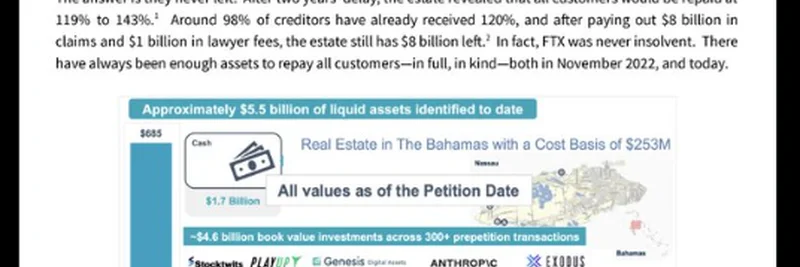Remember the FTX meltdown back in 2022? It was one of the biggest shocks in crypto history, leaving countless traders, including those dabbling in meme tokens, scrambling as billions vanished overnight. Fast forward to today, and Sam Bankman-Fried (SBF), the former CEO of FTX, has shared a document shedding light on where all that money went—or rather, how much of it ended up in lawyers' pockets.
In a recent tweet by Seb Montgomery, he highlights a staggering fact: lawyers have raked in $1 billion from the FTX demise. The tweet points to a Google Drive document penned by SBF and his team, titled "FTX: Where Did The Money Go?" This isn't just some rant; it's a breakdown of what should have happened versus what actually did, complete with charts and timelines.
Let's break it down simply. FTX was a major cryptocurrency exchange where people deposited funds to trade everything from Bitcoin to wild meme coins like Dogecoin or newer ones popping up daily. In November 2022, a liquidity crisis hit, meaning FTX didn't have enough readily available cash to cover withdrawals. According to SBF's doc, customers had stashed about $20 billion there, but a run on the bank—think everyone trying to pull out money at once—triggered the collapse.
But here's the twist: SBF argues FTX wasn't actually bankrupt. He claims there were enough assets to pay everyone back, and then some. The document lists around $5.5 billion in liquid assets identified so far, including cash, real estate in the Bahamas (costing $253 million), stocks, tokens, and more. After payouts to creditors at 120% or higher and shelling out that eye-watering $1 billion in legal fees, the estate still has $8 billion left.
Why does this matter for meme token fans? Meme tokens thrive on hype, community, and quick trades. Many got listed on FTX, drawing in retail investors chasing the next big pump. When FTX crashed, it wasn't just big players who got burned—meme token holders lost access to their funds, and the market sentiment tanked, causing prices to plummet. Centralized exchanges (CEXs) like FTX put your assets in someone else's hands, and if they mess up (or worse), you're at their mercy.
This is where the tweet's shoutout to @infinex comes in. Infinex is a decentralized superapp that combines a wallet, portfolio manager, and trading terminal, all onchain. Think of it as a CEX experience but without the central point of failure. It's non-custodial, meaning you control your keys and assets—no handing them over to a company that could go belly up.
Infinex aims to onboard 100 million users to safer crypto practices, potentially sparing them from FTX-like disasters. For meme token traders, this means swapping, staking, and bridging assets across chains without worrying about exchange hacks or bankruptcies. It's built to simplify DeFi (decentralized finance), which often feels clunky with gas fees and multiple approvals, making it more accessible for everyday users hyped on the latest meme coin.
A reply in the thread from another user jokes about forming an Infinex legal team to sue CEXs, highlighting the frustration with traditional exchanges. And Tyler Durden's comment in related discussions calls SBF a "fall guy" and warns of ongoing risks in the space.
The FTX saga reminds us that in crypto, especially with volatile meme tokens, decentralization isn't just a buzzword—it's a shield. Platforms like Infinex could be the bridge to a safer, more user-empowered future. If you're trading memes, consider shifting to onchain tools to keep your gains truly yours.
Stay informed on meme token trends and blockchain updates right here at Meme Insider. What's your take on the FTX fallout? Drop a comment below!


